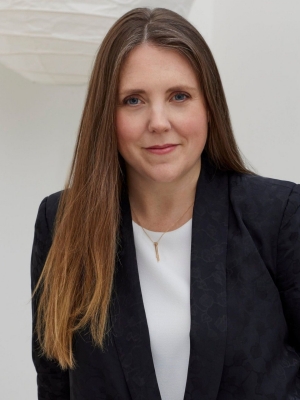After years of travelling for work and studies, Andria Hickey, MA 09, has finally settled closer to home. “Here I am, full circle back in Newfoundland in a totally different capacity,” she says.
A curator, writer and strategic adviser, Hickey — who was born and raised in St. John’s — is now the first-ever head of programs at Shorefast, a social enterprise, and Fogo Island Arts (FIA).
In addition to the FIA programming that includes artist residencies, exhibitions, public programs and publications, Hickey also oversees Shorefast’s environmental stewardship initiatives, culture and heritage preservation programming.
“This has broadened my thinking about how contemporary art intersects with these transdisciplinary areas of stewardship,” she says.
Hickey has been interested in the program, and Fogo Island more generally, for a long time: “It’s certainly felt like a place that has a real relevance in the global art world,” she says. “It was important for me to be closer to home and contribute in a different way, but also to have these connective wings out in the world.”
Carving a path through public spaces
A graduate of Concordia’s Department of Art History, Hickey is grateful for its interdisciplinary approach and for the emphasis placed on connections to contemporary art. “Martha Langford and Joanne Sloan, [BFA 83], each backed the ambitious ideas I wanted to explore,” she says. “It was a very supportive environment.”
Hickey had applied to Concordia’s MA in art history with an atypical undergraduate profile — her degree from Memorial University was in English literature, rather than art history.
“I showed Catherine MacKenzie some work I had done here in Newfoundland related to cultural policy for visual artists and some of my survey work,” she explains. “She was impressed and advocated for my admittance to the program. That was very special, because I didn’t have the requisite undergraduate degree.”
Later, as a graduate student, the artwork of Kara Walker was central to Hickey’s thesis project, which led her to apply for an internship at the Walker Arts Center in Minneapolis. Having secured a travel grant from Concordia to consult Walker’s exhibition, Hickey contacted the curators to alert them of her visit. “I hadn’t received a job interview request, but I reached out and they organized an interview,” she says.
“That position led to an incredible future set of opportunities that really helped to launch my career. One thing always leads to another in ways you don’t expect.”
In 2010, Hickey moved to New York to take on a curatorial role at Art in General. A year later, she was appointed curator at the Public Art Fund, a position that sparked her interest in publicly-engaged art and shaped her future work in museum and art gallery spaces.
“The relationships I observed working in public space related to thinking about whether or not — and how — art can be meaningful to people with wildly different backgrounds and knowledge of contemporary art,” she says, “and how important it is to think about that kind of diversity of audience when you're curating both inside and outside.”
A transition to the commercial world
While working as senior curator of Contemporary Art at the Museum of Contemporary Art Clevland, the CEO of New York’s Pace Gallery invited Hickey to apply for a curatorial director role. “At the time, this was a bit unusual,” Hickey says. “Few curators were moving from the non-profit to the for-profit world.”
Hickey began thinking about exhibitions and artist management from a curatorial lens. Hesitant, but excited to build something new in a contemporary gallery space, she assembled a curatorial team and launched the performing arts program, Pace Live.
“It was an incredible learning experience for me,” she says. “I think this is critical right now as our contemporary art world is very blurry. The market is always part of it, and the best way to understand how to navigate these two worlds is to learn about each.”
In addition to her curatorial work, Hickey offers strategic advice to cultural foundations, arts institutions, artists and recent graduates interested in a career in the art world.
“Student loans are real, and you need to make a living from your artwork,” says Hickey. “But if you can take the time to further develop your work after grad school — it will serve you in the long run. Your work will have that strength and foundation it needs to have a long career.”
Hickey also encourages art history grads to visit artists in studios. She herself just returned from the Venice Biennale as part of her work with Fogo Island Arts, to see the latest in contemporary art, meet supporters and to connect with artists.
“As a curator, it’s crucial,” she says. “You need to see what people are doing, look for patterns — notice what makes you excited. That is really important.”
 Andria Hickey: “It was important for me to be closer to home and contribute in a different way, but also to have these connective wings out in the world.” | Photo credit: Melissa Goodwin
Andria Hickey: “It was important for me to be closer to home and contribute in a different way, but also to have these connective wings out in the world.” | Photo credit: Melissa Goodwin